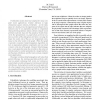Free Online Productivity Tools
i2Speak
i2Symbol
i2OCR
iTex2Img
iWeb2Print
iWeb2Shot
i2Type
iPdf2Split
iPdf2Merge
i2Bopomofo
i2Arabic
i2Style
i2Image
i2PDF
iLatex2Rtf
Sci2ools
109
click to vote
CVPR
2003
IEEE
2003
IEEE
PAMPAS: Real-Valued Graphical Models for Computer Vision
Probabilistic models have been adopted for many computer vision applications, however inference in highdimensional spaces remains problematic. As the statespace of a model grows, the dependencies between the dimensions lead to an exponential growth in computation when performing inference. Many common computer vision problems naturally map onto the graphical model framework; the representation is a graph where each node contains a portion of the state-space and there is an edge between two nodes only if they are not independent conditional on the other nodes in the graph. When this graph is sparsely connected, belief propagation algorithms can turn an exponential inference computation into one which is linear in the size of the graph. However belief propagation is only applicable when the variables in the nodes are discrete-valued or jointly represented by a single multivariate Gaussian distribution, and this rules out many computer vision applications. This paper combines belief prop...
Algorithm Performs Inference | Belief Propagation | Belief Propagation Algorithms | Computer Vision | Conditional Probability Distributions | CVPR 2003 | Exponential Inference Computation |
Related Content
| Added | 12 Oct 2009 |
| Updated | 12 Oct 2009 |
| Type | Conference |
| Year | 2003 |
| Where | CVPR |
| Authors | Michael Isard |
Comments (0)

